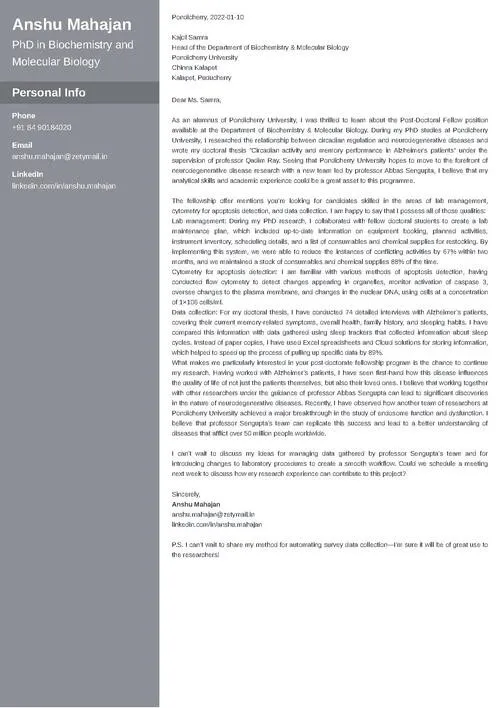Understanding the Importance of a Postdoc Cover Letter
A compelling cover letter is your first chance to make a positive impression on the hiring committee when applying for a postdoc position. Unlike a resume or CV, which provides a comprehensive overview of your academic and professional history, the cover letter allows you to showcase your personality, express your enthusiasm, and demonstrate how your specific skills and experiences align with the requirements of the position and the research group. It is a crucial opportunity to elaborate on the key aspects of your application, providing context and demonstrating your suitability for the role. A well-crafted cover letter can significantly increase your chances of securing an interview and ultimately, landing the postdoc position you desire. It provides the committee with a clear understanding of why you are interested in this specific position.
Key Components of a Postdoc Cover Letter
A strong postdoc cover letter should be well-structured, concise, and tailored to the specific position and research group. It should highlight your relevant skills, research experience, and accomplishments, while also demonstrating your understanding of the research area and your enthusiasm for the opportunity. The letter should also be free of errors and easy to read. The following sections are essential for a compelling cover letter. It is very important to read and understand the job description before writing the cover letter, because cover letters need to be tailored.
Contact Information and Introduction
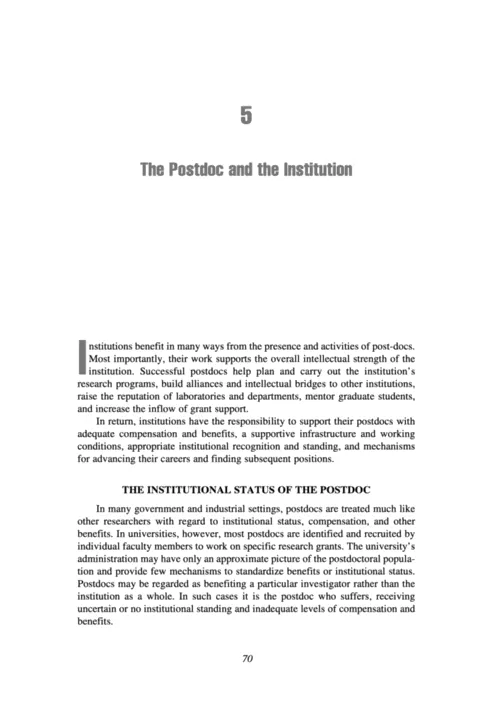
Start with your full name, contact information (email, phone number, and address), and the date. Address the letter to the hiring manager or the principal investigator (PI) by name, if possible; this shows that you have taken the time to research the position and the group. In the introduction, clearly state the position you are applying for and where you found the advertisement. Briefly introduce yourself and your primary research interests, then immediately express your enthusiasm for the opportunity and the research group. This initial paragraph sets the tone for the rest of the letter and captures the reader’s attention.
Highlighting Research Experience
This section is crucial, as it allows you to elaborate on your research experience in detail. Mention your previous research projects, your role in each project, and the specific techniques and methodologies you used. Emphasize your accomplishments and contributions to these projects, such as publications, presentations, and any significant findings. Tailor this section to the specific requirements of the postdoc position; highlight experiences that directly align with the research interests and goals of the hiring group. Do not just list your accomplishments; explain how your experience makes you an ideal candidate for the role.
Showcasing Skills and Achievements
Focus on the skills and achievements most relevant to the postdoc position. This could include specific laboratory techniques, data analysis skills, software proficiency, or grant writing experience. Highlight any awards, fellowships, or honors you have received, as these can significantly strengthen your application. Provide specific examples of how you have utilized these skills in the past and the positive outcomes that resulted. Use action verbs to describe your accomplishments and focus on what you have achieved, rather than just listing your responsibilities. It is very important to match the skills with the research project’s requirements.
Quantifying Accomplishments
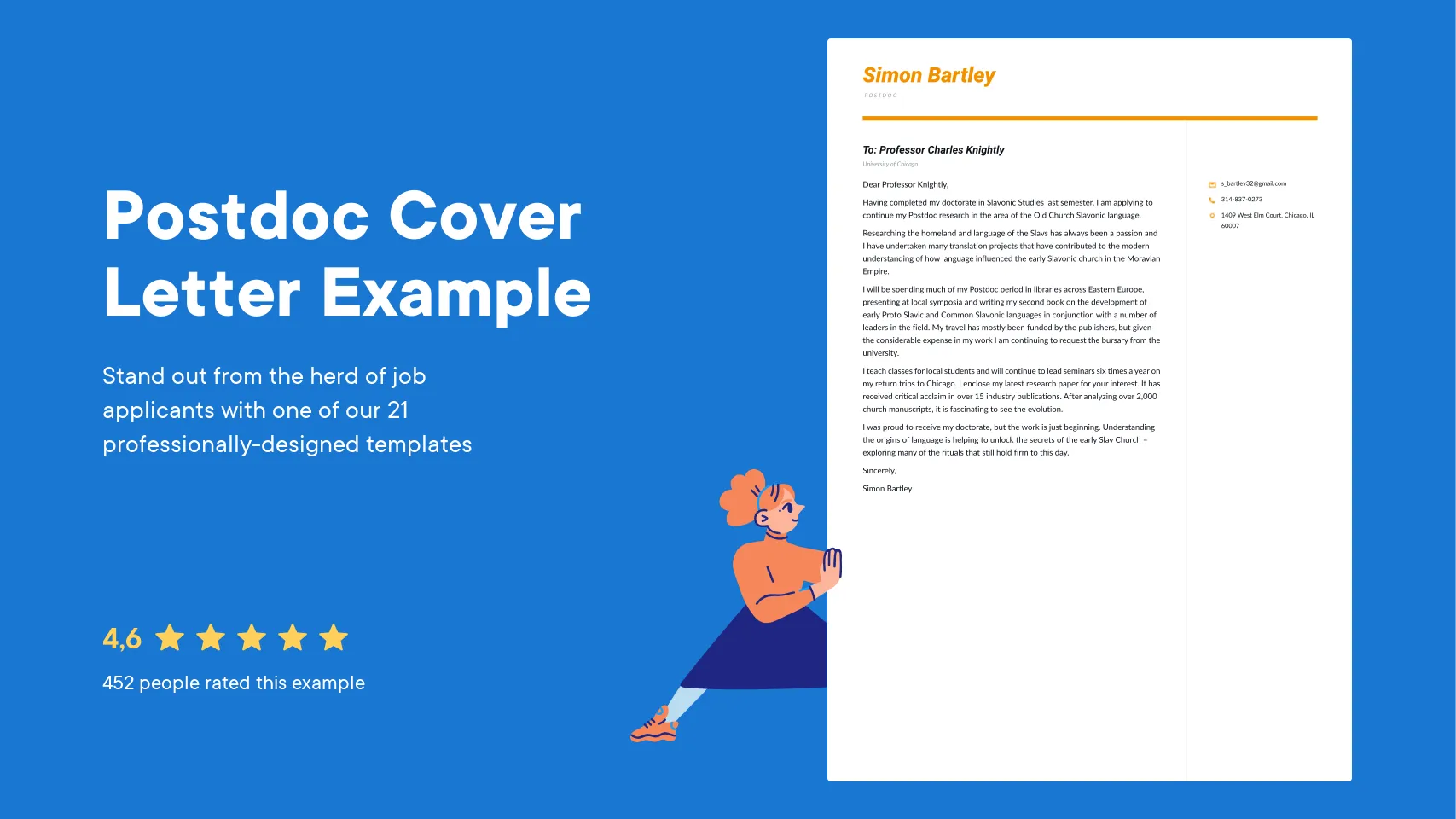
Whenever possible, quantify your accomplishments to demonstrate your impact. Instead of saying you ‘managed’ a project, state that you ‘managed a project involving a team of five researchers that resulted in three publications in peer-reviewed journals.’ If you were involved in grant writing, mention the amount of funding secured. Use numbers and statistics to provide concrete evidence of your achievements. This demonstrates your ability to make tangible contributions and provides the hiring committee with a clearer understanding of your value. For example, you could mention the number of publications, the impact factor of the journals, or the number of citations your work has received. This makes your accomplishments more impactful.
Demonstrating Alignment with the Research Group
Research the principal investigator (PI) and the research group thoroughly. Read their recent publications to understand their current research interests and goals. In your cover letter, explain why you are interested in joining this specific group and how your research interests align with theirs. Mention specific projects or areas of research that excite you. Demonstrate your understanding of the group’s work and explain how you can contribute to their ongoing projects. Show that you are not just applying for any postdoc position, but that you are specifically interested in this opportunity because of the research being conducted. This shows the committee that you are genuinely interested in their work and not just applying for any available position.
Explaining Your Interest in the Position
Clearly articulate why you are interested in the postdoc position. Explain what aspects of the research, the group, or the institution appeal to you. Are there specific techniques you are eager to learn or projects you are excited to contribute to? Do you have particular career goals that align with this position? Show the hiring committee that you have thought deeply about why this position is a good fit for your skills and goals. Personalize this section by referencing specific aspects of the research or the group’s work that resonate with you. This will show that you are not just sending out a generic cover letter.
Highlighting Relevant Skills
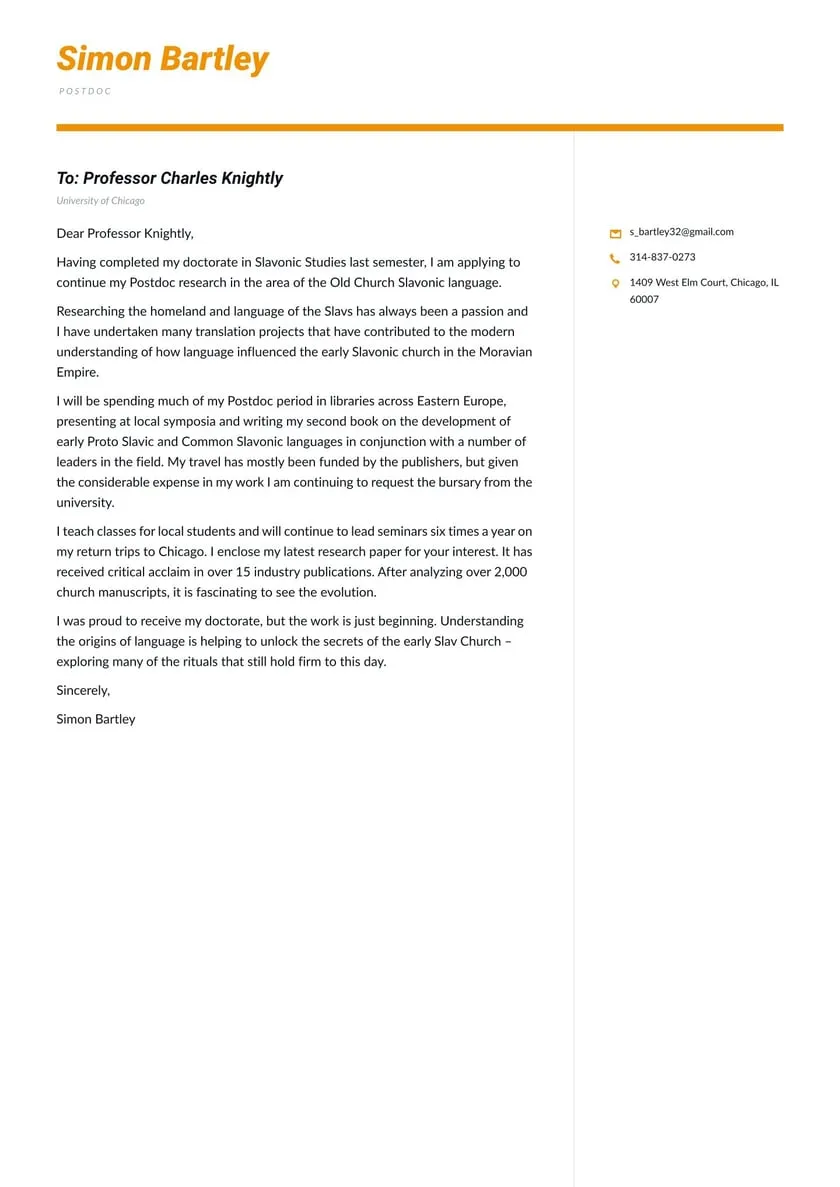
Focus on the skills that are most relevant to the postdoc position’s requirements. Match your skills with the job description, and provide concrete examples of how you have used these skills in the past. This is an opportunity to showcase your technical expertise, your problem-solving abilities, and your capacity for independent research. Mention any software, equipment, or methodologies you are proficient in. If the position requires a particular skill that you lack, consider mentioning your willingness to learn and your ability to quickly acquire new skills. Be specific and use action verbs to describe your capabilities, demonstrating what you have done, not just what you know.
Addressing Potential Weaknesses
It is important to address any potential weaknesses or gaps in your application proactively. If you have a career gap, briefly explain the reason and how you used that time productively. If you lack a particular skill mentioned in the job description, mention your eagerness to learn and your experience in acquiring new skills. Frame any weaknesses in a positive light, focusing on what you have learned from the experience and how it has made you a more resilient and adaptable researcher. Being honest and upfront about any potential weaknesses can demonstrate your self-awareness and your ability to address challenges. The key is to acknowledge the weakness and then focus on the steps you have taken or will take to mitigate it.
Concluding the Letter
In the concluding paragraph, reiterate your interest in the position and thank the hiring committee for their time and consideration. Express your enthusiasm for the opportunity to contribute to the research group and reiterate your suitability for the position. Include a call to action, such as stating that you are available for an interview at their earliest convenience or that you look forward to hearing from them soon. Make sure to include your contact information once more. End your letter with a professional closing, such as ‘Sincerely’ or ‘Best regards’, followed by your typed name. Do not forget to proofread it one last time to make sure everything is perfect.
Proofreading and Formatting Tips
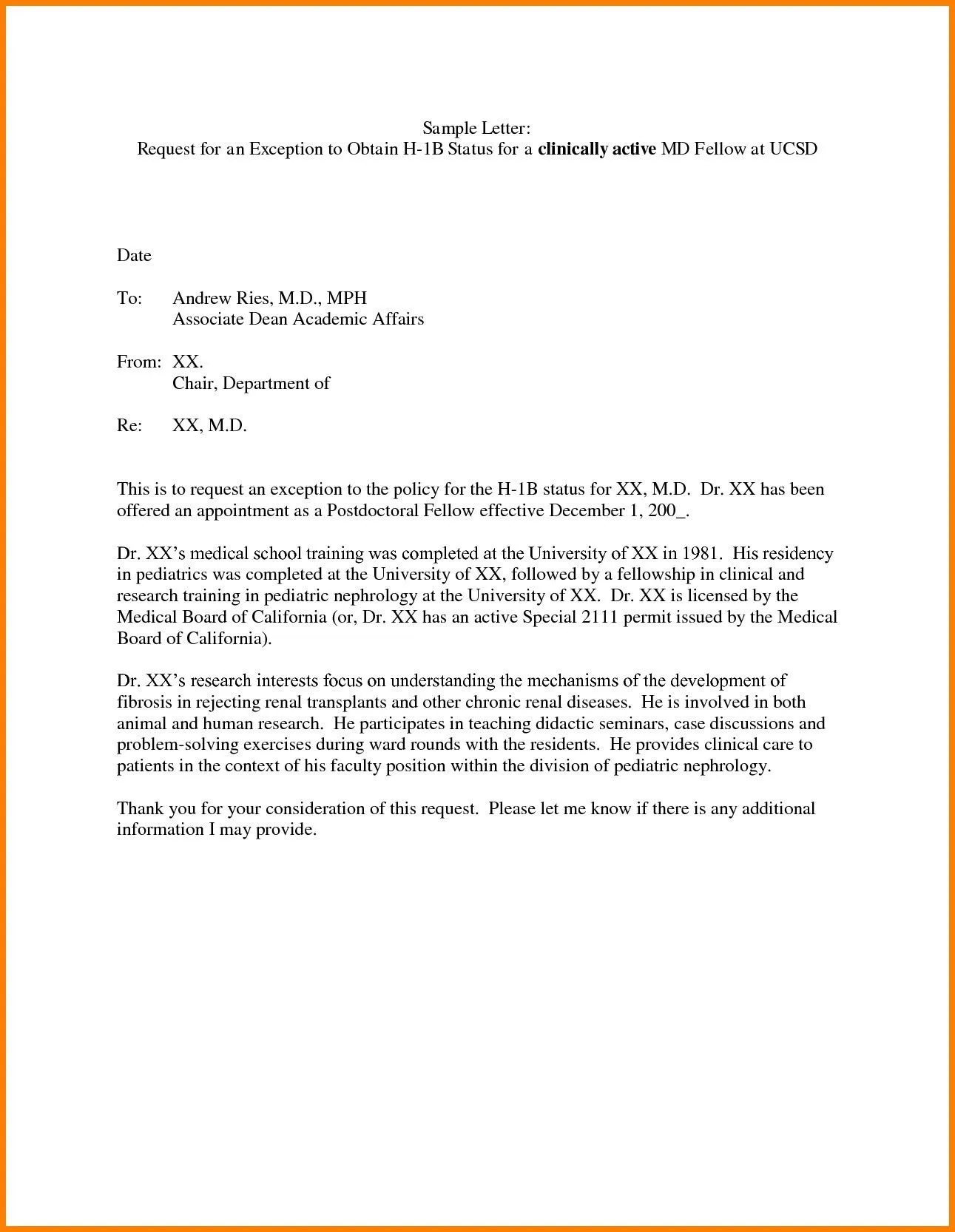
A well-formatted and error-free cover letter is crucial for making a positive impression. Pay close attention to the layout, grammar, and spelling. Proofreading is one of the most important parts of the process. A cover letter full of errors can damage your chances, because it shows a lack of attention to detail. Your ability to write and communicate effectively is just as important as your research skills, so take the time to perfect every aspect of your cover letter.
Formatting the Cover Letter
Use a professional and easy-to-read font, such as Times New Roman, Arial, or Calibri, with a font size of 11 or 12 points. Use single spacing within paragraphs and double spacing between paragraphs. Keep the letter concise, ideally one page long, unless the job description specifically requests more. Use clear headings and bullet points to organize your information and make it easy for the reader to scan. Ensure the letter has consistent margins and spacing. Pay attention to the overall appearance of the letter, making sure it looks clean and well-organized. Proper formatting demonstrates your attention to detail.
Proofreading for Errors
Proofread your cover letter carefully for any errors in grammar, spelling, and punctuation. Use a spell checker and grammar checker, but also manually proofread the letter. Ask a friend, mentor, or career advisor to review your cover letter, as a second pair of eyes can often catch errors that you might miss. Read the cover letter aloud to yourself to catch any awkward phrasing or sentences that do not flow smoothly. Make sure all the details in the cover letter match your CV, and the information you provide is consistent. The goal is to present a polished document that highlights your strengths.
Using Keywords Strategically
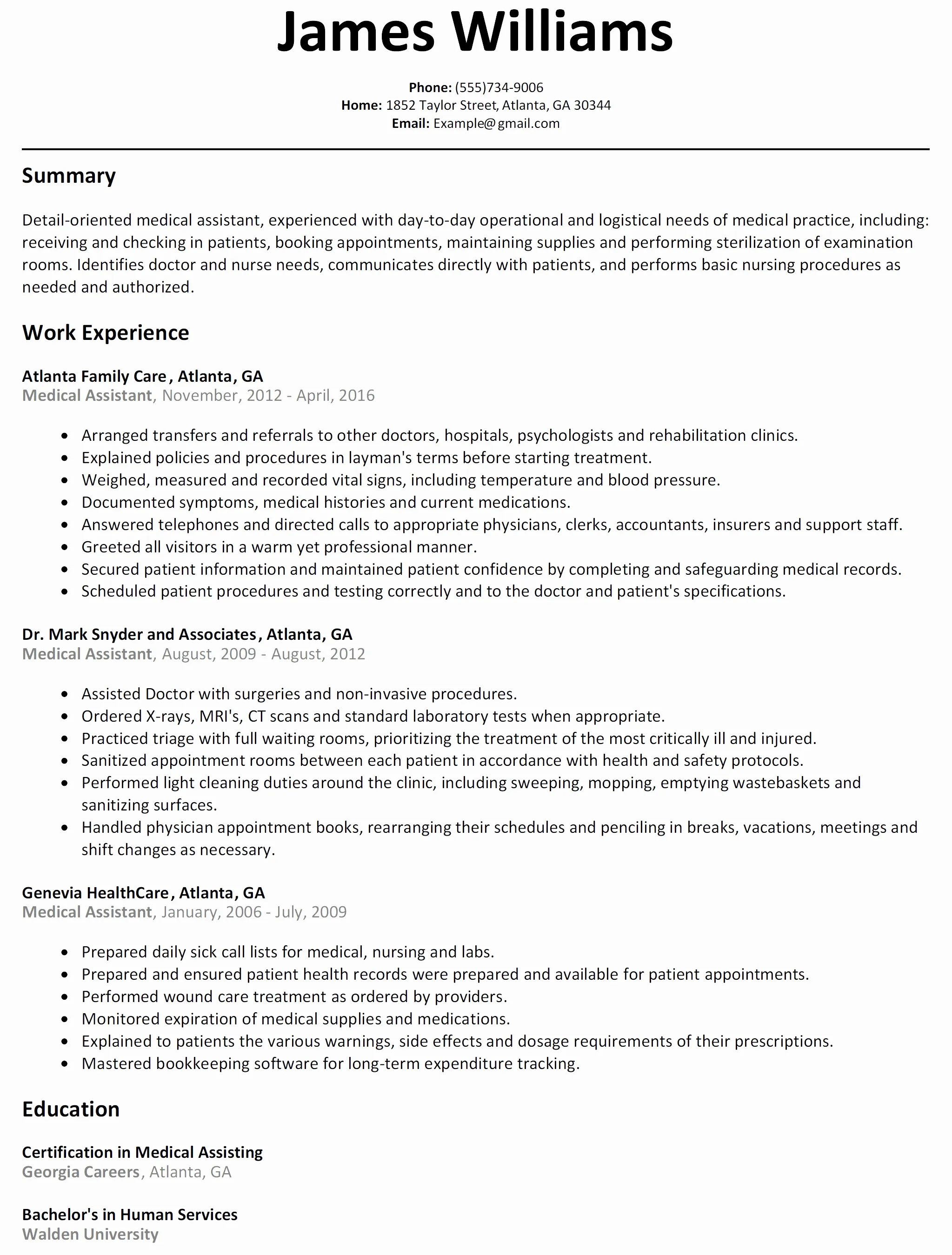
Carefully review the job description and identify the key skills, qualifications, and keywords mentioned. Use these keywords throughout your cover letter, but avoid keyword stuffing. Naturally incorporate the keywords into your sentences to demonstrate that you possess the required skills and experience. This helps the hiring committee quickly identify your qualifications and assess your suitability for the position. Do not just throw keywords into the cover letter without any context; provide examples to demonstrate your expertise. This is not only good for the potential employer, but also for the applicant. You are showing you possess all the requirements.
Postdoc Cover Letter Dos and Don’ts
To increase your chances of success, it is helpful to understand the general best practices, but also what you should avoid. Here are some key tips.
Do
- Tailor your letter to the specific position.
- Highlight relevant skills and achievements.
- Quantify your accomplishments.
- Demonstrate your interest in the research group.
- Proofread carefully.
- Keep it concise and well-formatted.
Don’t
- Use a generic cover letter.
- Repeat information from your CV.
- Be overly casual or informal.
- Focus solely on your needs.
- Exceed one page, if possible.
- Submit a letter with errors.
